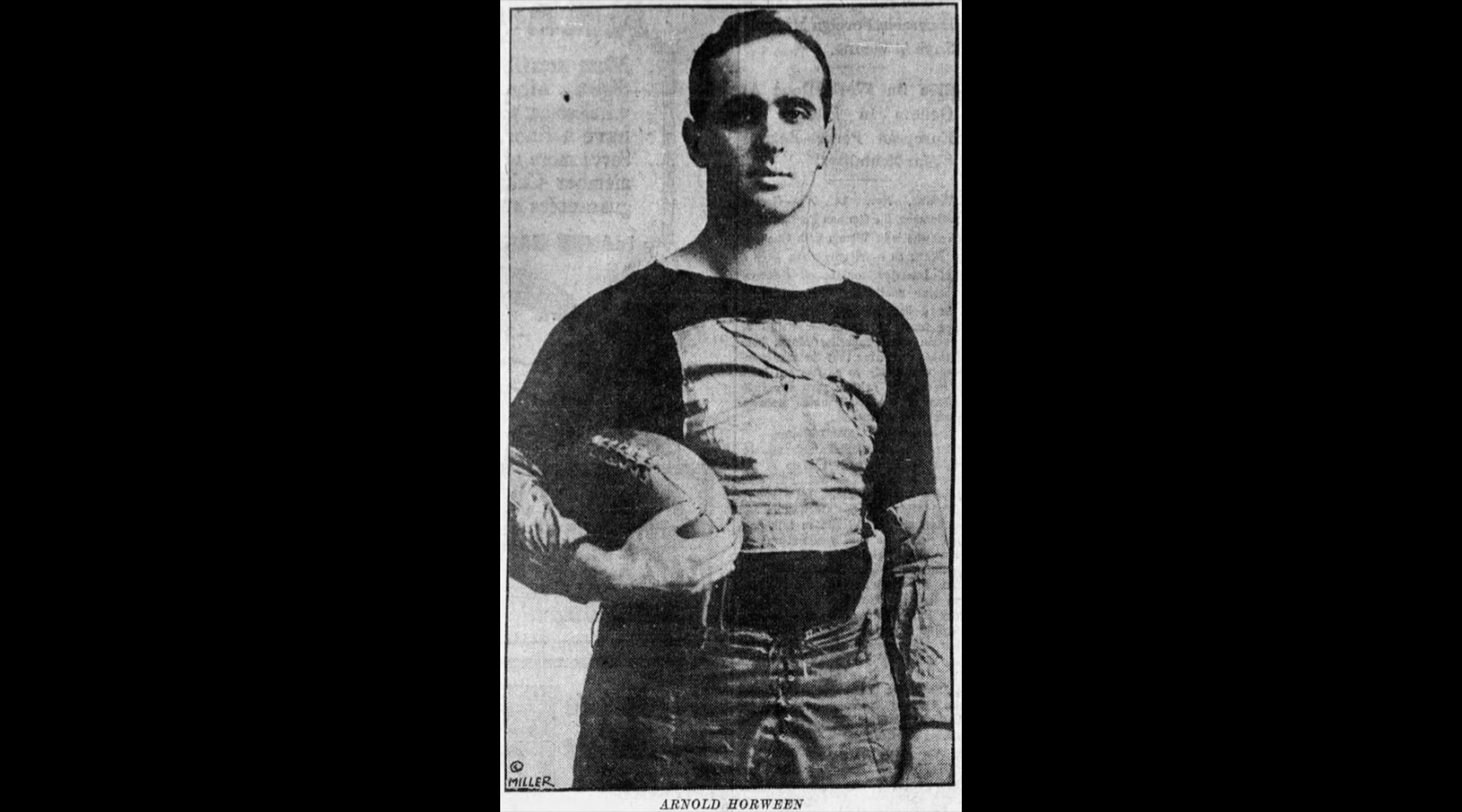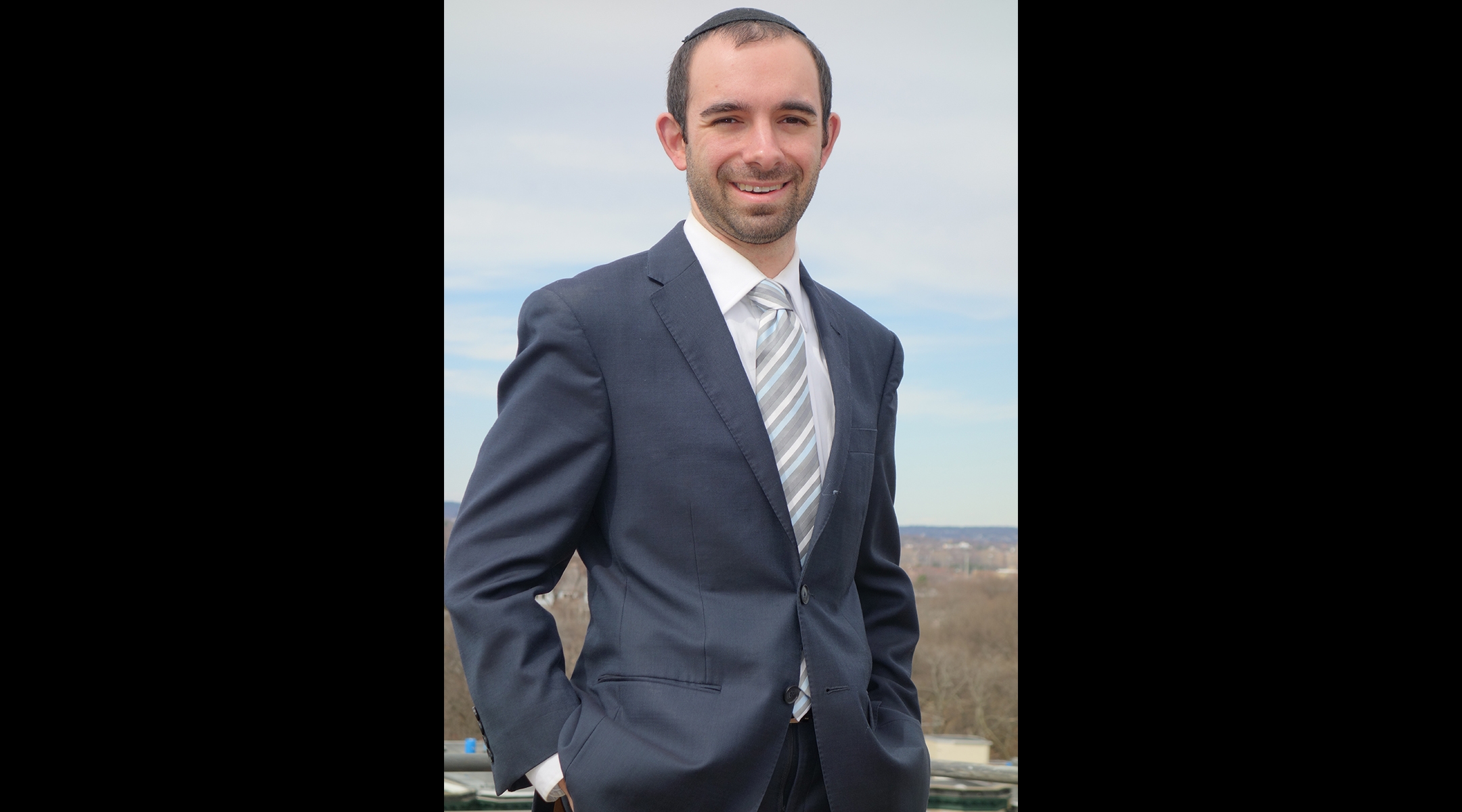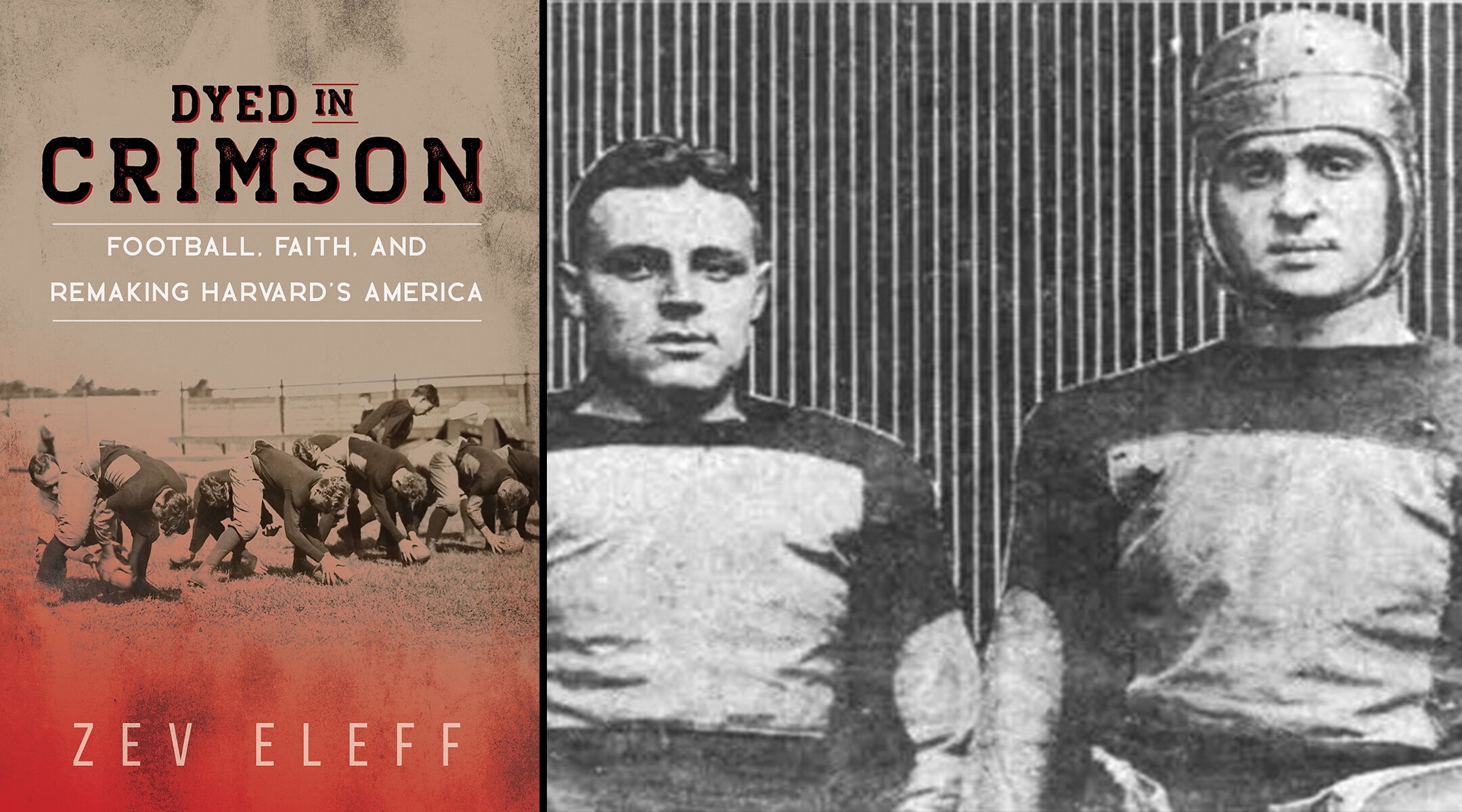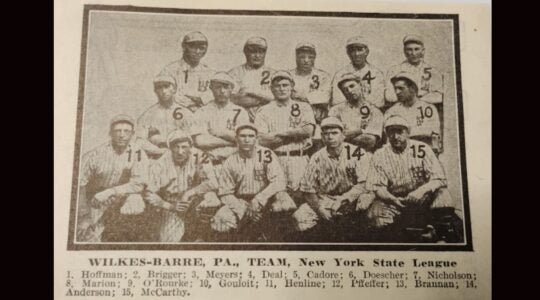(JTA) — Decades before Sandy Koufax sat out the first game of the 1965 World Series because it fell on Yom Kippur, and 18 years before Greenberg chased Babe Ruth’s single-season home run record in the late 1930s, a college athlete made some overlooked Jewish sports history.
Arnold Horween, a burly Chicagoan, became the first Jewish captain of the Harvard University football team in 1920 — an achievement that sent ripples through American culture.
Horween, who would later play and coach in the early years of what would become the NFL, was born to Jewish immigrants from Ukraine. He became a star player at Harvard, helping the Crimson go undefeated in both 1919 and 1920 after returning from serving in World War I. (His brother Ralph also played at Harvard and in the NFL, and they were the first and only Jewish brothers to play in the NFL until Geoff and Mitchell Schwartz.)
But it was Horween’s unanimous selection as the team’s captain, and more importantly, his appointment in 1926 as the team’s coach, that would prove unprecedented.
“In American Jewish culture, the only thing greater than being the captain of the Harvard Crimson, the only higher station in American culture might have been the president, or the coach of Harvard, which he eventually becomes,” said Zev Eleff, the president of Gratz College and a scholar of American Jewish history.
Eleff explores Horween’s story and its impact in his recent book, “Dyed in Crimson: Football, Faith, and Remaking Harvard’s America,” released earlier this year. He traces the history of Harvard athletics in the early 1900s, exploring how Horween, along with Harvard’s first athletic director, Bill Bingham, altered the landscape of America’s most prestigious college.
Horween’s ascendance came at a time when Harvard instituted quotas to limit the number of Jewish and other minority students it accepted — a practice the school would employ throughout the 1920s and 30s. His story also took place amid a political landscape that featured the rise of Father Charles Coughlin, the antisemitic “radio priest,” and the reemergence of the Ku Klux Klan.
As Eleff underscores in the book, Horween did not fit the model of a “Boston Brahmin,” the class of elite, Christian, aspirationally manly men whose supremacy was unquestioned at Harvard Yard. Horween broke that mold, instead instilling a team culture where a love of the sport was almost as important as winning — the Ted Lasso effect, if you will.
“Dyed in Crimson” also uses early 20th century Harvard as an allegory for the broader theme of how sports can change society.
“The theme of the book, something that’s uniquely American, is how the periphery can influence the mainstream,” said Eleff. “How people on the sidelines can really make an influence.”
Eleff spoke to the Jewish Telegraphic Agency about how Horween’s story fits into the pantheon of Jewish American sports legends and what it says about Jews’ ability to succeed in America.
This conversation has been edited for length and clarity.
Let’s dig into Horween’s story. I liked the idea of him as like an earlier version of Koufax or a Greenberg, but to be honest, I had never heard of him. Why do you think his story isn’t as well known as other Jewish athletes?
I think it has everything to do with the emergence of Major League Baseball. College football was America’s sport in the 1910s and 1920s. It was a big money sport, when there was very little money outside of the New York Yankees. And I think that Horween’s star started to sort of decline with Harvard football, but also the emergence of other sports.
The other reason is because the idea of the Jewish ballplayer loomed large. The New York Giants, for decades, tried to identify a Jewish superstar. They actually passed on Greenberg. There was a thought after Greenberg that there was Jewish DNA for baseball, and the signing of Koufax was directly linked to this notion. It was this eugenics-like link that you need a Jewish ballplayer. For the Giants, it was ticket sales. So the commotion about Greenberg and Koufax is more about Jewish identity. And baseball is, as a professional sport in New York, Queens, Brooklyn, the Bronx, different than college football, particularly in New England at this time. Frankly, Jews lived near the Polo Grounds, they didn’t live near Harvard Yard.

Arnold Horween shown in The Baltimore Sun on November 16, 1927. (Wikimedia Commons)
For Horween, obviously he’s not at the level of a Greenberg or Koufax talent-wise, but he also didn’t seem to care as much personally about his Jewish identity. You write in the book that there were some Jews who took issue with the fact that Horween was not practicing, but there were also many Jews who were simply proud he was Jewish. What do you think about that dynamic?
There becomes a sort of disconnect between lived religion and the perception and what they come to represent — the mantle that they wear almost towers above the practice. Horween eschewed the opportunity to claim the mantle of Jewish leadership, Jewish celebrity. But we do see in its moment that he is the topic of rabbinic sermons, that The American Hebrew and other Jewish press are reporting on him. They are elated. In American Jewish culture, the only thing greater than being the captain of the Harvard Crimson — it’s hard for people to realize, but in the moment when they were part of the big three [alongside Princeton and Yale] — the only higher station in American culture might have been the president, or the coach of Harvard, which he eventually becomes.
One of the parts of this book that I enjoyed learning about is the extent to which college football in the early 20th century was all about honor, masculinity, gentlemanliness. And at the time, that kind of stands in contrast to how Jews were viewed — that Jews were not masculine, Jews couldn’t fit into that mold of the “Harvard man.”
Being on the sports team, that was probably far beyond Jewish expectations. Not to say that Jews could not be athletic, but very often the varsity players weren’t picked for their talent but rather their surnames. What the sea change at Harvard is, [within] gentlemanly culture — in which “gentlemanly” is a Protestant, Christian masculinity — Horween is not Protestant. What allows him a pathway into that elite group is that drive to win. And as a player, he’s good luck. He never loses. He becomes a signature player for victory who even wins the Rose Bowl.
But as a coach, he subverts that. What he and Bill Bingham do is their campaign isn’t necessarily for winning, it’s for having fun, it’s for enjoying the game.
In the 1910s and 20s, college football was the peak of American sports, but that’s certainly not the case anymore. What do you think would be the modern comparison for someone like Horween?
Is Becky Hammon with the Spurs, the first woman [to act as] head coach in basketball, something like that? Or the very important discussions about people of color as coaches in the NFL? Sports and education are, for some reason or another, where change is made in American life. Brown v. Board of Education in 1954 ends, at least officially, segregation. Title IV, what is basically American law for anti-discrimination based on sex, is based on women’s college sports. You have the breaking down of color barriers and Jackie Robinson, Muhammad Ali and Vietnam. You have the first [openly] gay athletes, you have questions of breaking the glass ceiling for women and Serena Williams.
It’s absolutely 100% true that sports doesn’t matter. Who wins the World Series is of no great consequence to most people’s lives. Although it’s interesting, if you drive up I-95 on a Sunday, you will see that the bumper stickers and the flags change. There is some sort of passion, obviously, about sport. But it’s absolutely true that for some reason or another in the 20th century and 21st century in American sport, really important social and cultural decisions, and political decisions, are made in American sport.

Zev Eleff, president of Gratz College and author of “Dyed in Crimson.” (Courtesy)
Another main topic in the book is that the goal for immigrants, especially Jews, was Americanization, assimilation — that to become part of the mainstream was the marker of success. But that seems to be the case for Jews in a very different sense than it is for Catholics and for Blacks.
The major contribution of this book to American Jewish history beyond telling this story is to complicate notions of Americanization. Jews and Catholics in particular view Americanization very, very differently. The Catholic experience is to create parallel systems. If you’re a good Catholic boy with immense football talent, play for Notre Dame, play for Boston College. Don’t play for the Protestant mainstream. Cream them on the football field. Create parallel systems.
The Jewish experience is not so. Outside of Orthodox day schools in the early 20th century, it was anathema, it was considered almost heretical, for American Jews to [go] to private schools. To the contrary, the so-called golden citadels of the public schools — that is the agent of Americanization. Jews don’t establish their own educational systems. They somehow Americanize and acculturate into the mainstream. We don’t compete with Harvard, we get into Harvard.
Thinking about the antisemitism of that time — the quotas, Father Coughlin, all of that — how do you think that compares to what we’re seeing today?
Historians disagree about the 1920s. Was it a time of great prominence of American Jews? There was affluence in the roaring ’20s. There were institutions that were created, there was creativity, from the Orthodox and Mordecai Kaplan certainly, across the board, the Jewish Theological Seminary. American Judaism was at a certain high point in the 1920s. At the same time, there were quotas, and there was rising antisemitism. I think today we also have to deal with the tension of, on the one hand, there are great opportunities for Jews in the United States; at the same time, there is antisemitism. And so from the 1920s to the 2020s, 100 years later, you see a model for how to grapple with those tensions.
What do you hope, more than anything else, someone takes away or learns from your book?
It’s a book that begins like a punch line: a working class Protestant, a Catholic and a Jew walk into a football field. But it ends with something I think a lot more pronounced, which is, it’s a story about change. As a historian, I study change, particularly in American Judaism, broadly in American religion and Jewish Studies. Change is the best asset that a historian has to study. I wasn’t interested in just finding another Sandy Koufax story, replicating that story. This is a story that isn’t just about a Jew who happened for his moment to become quite successful and quite famous, or a Catholic or a former mill hand turned first athletic director in college history. It’s really about how people on the periphery influence the mainstream.
JTA has documented Jewish history in real-time for over a century. Keep our journalism strong by joining us in supporting independent, award-winning reporting.






